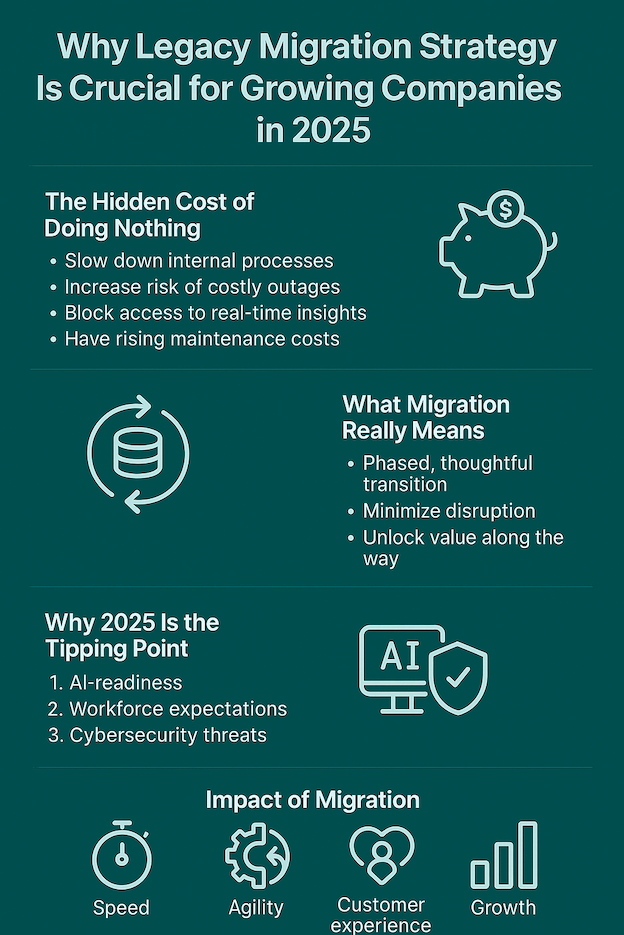We all know the pace of innovation has become relentless. There is constant pressure to personalise and increasing demands for improved customer experience that span all areas of business. In a climate like this, your systems either help you scale, or hold you back.
Many of the systems running in the background were built for a different time — long before mobile-first experiences, real-time data flows, and AI-assisted everything became the norm. They weren’t designed for the agility, flexibility, and seamless integration that businesses now depend on.
Legacy systems have a way of quietly choking growth. They can slow down workflows, reinforce silos between teams, and increase the risk of breakdowns that no one can afford. The longer they stay, the harder it is to move forward.
But moving forward isn't as simple as swapping out old tools for new ones. A strong, considered legacy migration strategy is about transitioning thoughtfully — carrying forward what still works, clearing out what doesn’t, and setting things up to scale with you. It’s not a rip-and-replace job. It’s an opportunity to realign your tech with your people and your goals.

The Hidden Cost of Doing Nothing
If your systems still technically function, it’s tempting to leave them be. After all, upgrades cost time and money. But “still working” doesn’t mean “still helping.”
Legacy systems tend to become invisible burdens. They slow internal processes. They make it harder to integrate with new tools or platforms. They block access to real-time insights. And their maintenance costs — both financial and operational — creep up year after year.
What Migration Really Means
Done right, migration delivers real-world results. But it’s not about chasing the next shiny software. A well-planned legacy migration strategy is phased, deliberate, and tailored to the needs of your business.
It’s a chance to rethink how your systems serve your people:
- Streamlined operations free up time and reduce redundancy
- Unified data enables clearer decision-making
- Modern compliance tools reduce regulatory risk
- New capabilities — from smart automation to AI — become accessible
There’s no universal roadmap. Some organisations benefit from a quick “lift and shift” to the cloud. Others need a deeper re-architecture, where big, rigid platforms are broken down into modular, API-connected systems. In most cases, a hybrid approach is best: start where the pain points are most felt, building momentum from there.
Why 2025 Is a Turning Point
Three big forces are making this the year to act:
1. AI-Readiness
Generative AI is no longer a side project — it represents a paradigm shift in how businesses operate in every function. To enable it, your data needs to be accurate and reliable so that when its connected, you aren't seeing old problems move faster. Most legacy platforms can’t keep up.
2. Employee Expectations
Today’s teams expect tech that just works — fast, intuitive, and collaborative. Outdated systems frustrate them and slow them down, and that frustration can cost you great people.
3. Cybersecurity Pressures
Older platforms often lack the defences needed to counter modern security threats. Moving to newer systems isn’t just about efficiency — it’s about protecting your business and your customers.
The Payoff: Growth, Unlocked
A smart migration unlocks value you can see and measure:
- Speed: Teams move from idea to execution faster.
- Agility: Your business can adapt without tech slowing it down.
- Customer experience: Modern systems allow for the personalised, consistent experiences customers now expect as standard.
- Growth: With stronger data and better infrastructure, your company can scale with confidence.
Migration, in short, is not just an IT concern. It’s a growth strategy.
Final Thought
Holding onto outdated systems might feel safer in the short term, but the longer you wait, the steeper the curve can become. A strong legacy migration strategy doesn’t just replace old tech. It builds a foundation for what’s next.
In a market that rewards speed, security, and seamless experience, the businesses that succeed in 2025 will be the ones that didn’t wait for their systems to catch up — they led the way instead.







